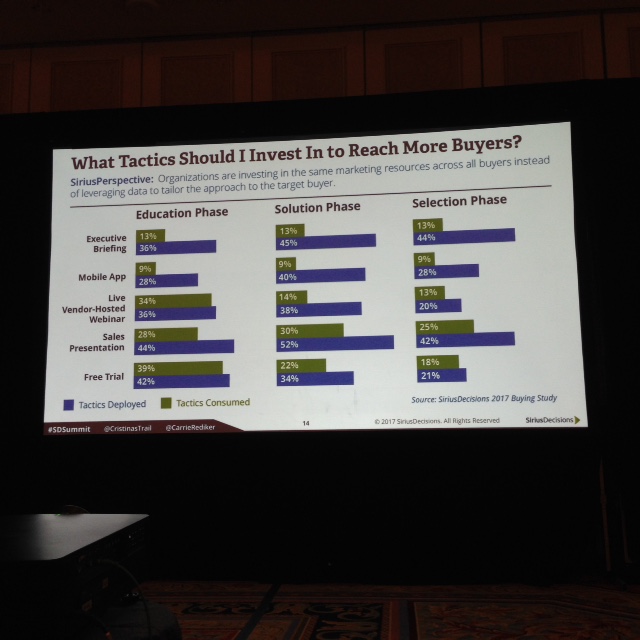Probably the biggest struggle content marketers face is getting insights to flesh out and validate their buyer personas. Helping to gain that insight was the subject of the SiriusDecisions 2017 Summit session “Making Personas Personal: SiriusDecisions Buyer Insights 2017.” In this extremely well-attended session, SiriusDecisions’ Cristina De Martini, research director of marketing operations strategies, and Carrie Rediker, research director of demand creation strategies, shared some of the insights from the SiriusDecisions 2017 B-to-B Buying Study.
Some of the results may surprise you.
As we have all learned, the buying process has evolved to include a variety of different channels and each person takes a different route along the standard buyer’s journey. As our understanding and tools become more sophisticated, we need to understand our personas and their preferences, and give them more power over how they take that journey.
Here’s a look at some of the questions the survey asked and some of the insights that were gleaned from the responses.
How Do Customers Buy?
The foundational decision process framework, based on our human cognitive process, is still valid. Buyers go through the education, solution and selection stages. Before delving into how customers buy, we have to review the three buying scenarios:
- Committee. This is the scenario for larger deals, typically $500,000 and up. Here you’re going to have to sell up through the organization, perhaps to five or more buying centers and six to 10 (or even more) individuals.
- Consensus. From about $50,000 to $500,000, you’ll still have multiple buying centers, but they are more likely to be on the same level in the organization.
- Independent. These smaller deals are typically e-commerce or transactional with a single individual in a short period of time.
To understand how these scenarios play out, it’s critical to create a buyer journey map. Answering some more questions about the buyer’s journey will help us do that.
Is Digital Replacing Human Interaction?
The short answer to this question is no. There is still close to a 50/50 split at each stage of the buyer’s journey. As we develop content, we need digital and human touches. Some interesting insights from these questions included the following:
- The average number of interaction types along the buyer’s journey is 18.
- There is no single tactic that drives closing a deal. It depends on the persona.
- When determining ROI, think across tactics because they all interact with each other.
- When interacting with humans, the vendor sales rep is the number one contact, more than twice as often as other contacts like resellers or analysts.
- Human interaction is preferred at some stage of the buyer’s journey, not only the end. However, when that human interaction comes really depends on the persona.
Now, let’s look at the next question.
What Tactics Should We (As Marketers) Invest In?
It’s always fun to look at tactic trends, but it’s important to remember that those trends may not apply to our target personas. Again, there’s no silver bullet when it comes to content type.
In fact, the tactics personas prefer tend to be evenly distributed. The big “but” is that it varies by persona when to use these tactics. By learning more about what our personas want and when, we can eliminate a lot of wasted time and money on tactics that don’t match their unique journey.
At this point, Cristina and Carrie presented a matrix of delivery of digital versus human and the level of response by type of delivery. At the top right with high human interaction and high response was “orchestrated,” which includes direct vendor engagement, vendor-hosted webinars, meetings with reps, vendor-hosted conferences, and dialog with a reseller or distributor. This had a 32% response rate.
What was interesting is that the top six tactic types for CIOs and line of business executives were the same, but they occurred at different stages of the buyer’s journey. The top six, in order, are:
- Analyst reports: 32%
- Sales presentations: 28%
- Case studies: 22%
- Interactive brochures: 22%
- Articles: 20%
- Static brochures: 16%
This means that case studies or white papers can be used effectively in the education, solution, or selection stage — depending on the persona.
Which brings us to our next question.
What Affects Deal Velocity?
Nearly three quarters of deals get stuck somewhere in the buyer’s journey, the study revealed. What’s more interesting is breaking down the reasons that we, as marketers, can control versus those we can’t. Let’s start with what’s not in our control:
- Budget
- Competing organizational priorities
- Organization’s purchase process
Here’s what we can control:
- How quickly the vendor representative responds to the buyer
- Negotiation on price
- Assets that compare our solution to our competitors’
- Contract reviews
How Do We Apply This New Knowledge?
Here are the key takeaways.
- Personas matter. We need to dig deeper to understand how our buyers buy and preferences in the process.
- We need to leverage data to drive decisions, not rely on intuition.
- We can use data to fill gaps in content asset types.
- Demand generation, operations, and portfolio marketers need to collaborate to create data-driven buyer persona maps for each persona.
How do our customers buy? It all depends. We can start with data from surveys like this study from SiriusDecisions and then doing more research on our target personas. The result will be personas that are personal and let the buyer have a say in the journey.



